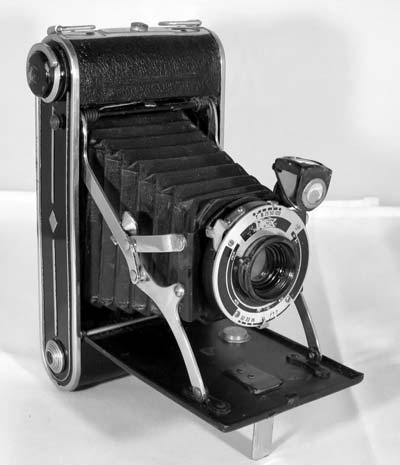Coronet Rex Folding 7.7
Specification

| Manufacturer | : | Coronet |
|---|---|---|
| Produced | : | 1930 |
| Classification | : | Medium Format |
| Body Type | : | Folding Bed |
| Bellows Deployment | : | Self Erecting |
| Construction | : | Metal |
| Film Type | : | 120 |
| Film Width | : | 62mm |
| Image Size | : | 2¼ x 3¼ |
| No. of Images | : | 8 |
| Lens Type | : | Doublet |
| Focal Length | : | 95mm |
| Focus Type | : | Variable |
| Focal Range | : | 6ft to inf. |
| Aperture Type | : | 7 leaf Iris |
| Apertures | : | f/7.7 to f/32 |
| Shutter Type | : | Everset scissor |
| Shutter Speeds | : | T, B, 1/25s, 1/50s, 1/100s |
| Size Open (w x h x d) | : | 80 x 155 x 125 mm |
| Size Closed (w x h x d) | : | 80 x 155 x 32 mm |
| Weight | : | 500g |
Art Deco Credentials
![]()
![]()
![]()
![]()
Significant: Pronounced and self evident
- Produced during the main Art Deco period.
- Geometric pattern on shutter plate.
- Raised line and diamond pattern in chrome on black enamelled sides
- Chrome used on complex curvilinear struts
- Embossed linear pattern on covering
- Chrome table stand with linear engraving
- Chrome winder knob
- Chrome film door latch with linear engraving
- Stepped concentric circles in chrome on tripod mounts
Description
This is a self erecting bellows camera manufactured in Aston, Birmingham, Great Britain around 1930 by Coronet Camera Co. This Coronet Rex is a metal camera with the body covered in imitation leather. The geometric pattern on the sides are constructed of raised chrome on a black enamel background. It uses 120 film producing a 6x9 cm negative. The camera is opened by pressing a button on the upper right side of the body which allows the front to fold out extending the bellows.
It has a doublet lens system with diaphragm apertures of f/7.7 to f/32. The lens employs front focusing with a range from 6 feet to infinity. It has a simple scissor shutter with speeds of 1/25, 1/50 and 1/100 seconds plus positions B and T. A lever at the top of the lens plate selects the speed whilst a lever at the bottom selects the aperture. The bright optical viewer is placed above the lens and swivels allowing it to be used for both landscape and portrait compositions. The film advance knob is not coupled to the shutter release and is used in conjunction with a red window the advance exposures. To replace the roll, open the back cover by pressing a button located on the top under the handle.
How to Use
This camera takes 120 film which is readily available. The red window should be kept covered except when advancing the film.
Shutter speeds available are 1/25s, 1/50s and 1/100s. Aperture range is f/7.7 to f/32.
If you don't want to bother with an exposure meter, follow the guide shown. It is based on the 'Sunny 16' rule. Film is so forgiving and will produce acceptable results even when overexposed by 2 or 3 stops or underexposed by 1 stop.
Remember that the exposure guide in the camera user manual may not be helpful as it is based on the use of old film with a low ISO value.
The tables assume that the sun is at least 30 degrees above the horizon - that's 10am - 5pm on a summer's day (May to August) in the UK.
If you are not sure about the light level, err on the side of overexposure - i.e. assume the smaller f number.
Where there is a choice, a larger f number will give a larger depth of field.
For the slower speeds, you may need a tripod to stop blur through shake.
Using ISO 100/125 film
| Weather Conditions | Shadow Detail | Shutter Speed (s) | ||
|---|---|---|---|---|
| 1/25 | 1/50 | 1/100 | ||
 Sunny SunnySnow/Sand | Dark with sharp edges | - | f/32 | f/22 |
 Sunny Sunny | Distinct | f/32 | f/22 | f/16 |
 Slight Overcast Slight Overcast | Soft around edges | f/22 | f/16 | f/11 |
 Overcast Overcast | Barely visible | f/16 | f/11 | f/7.7 |
 Heavy Overcast Heavy Overcast | None | f/11 | f/7.7 | - |
 Open Shade Open Shade/Sunset | None | f/7.7 | - | - |